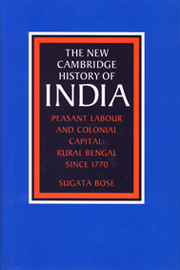Bibliographical essay
Published online by Cambridge University Press: 28 March 2008
Summary
Introduction
Scholars of colonial India have long been entranced by the intractable problem of 'land tenure', and enamoured of the age-old institution of Village communities'. While H. S. Maine provided the classical descriptive outline of the optical illusion of India's self-sufficient village communities in his Village Communities in the East and West, 3rd edn, London, 1879, B. H. Baden-Powell compiled a more hard-headed, if encyclopaedic, account of The Land Systems of British India, Oxford, 1892. A sophisticated early critique of the land systems established by the British was contained in Romesh C. Dutt, Economic History of India, Vol. II, In the Victorian Age, London, 1904, reprinted Delhi, i960. The more intense of the late-nineteenth-century debates continued to provide the points of departure for the burgeoning scholarship on South Asian agrarian history in the 1970s and 1980s.
£The return of the peasant to South Asian history' was heralded in the title of Eric Stokes' final essay in an insightful twelve-essay collection The Peasant and the Raj: Studies in agrarian society and peasant rebellion in colonial India, Cambridge, 1978. Its publication marked roughly the midpoint of two extraordinarily productive decades in the publication of research monographs and articles on the agrarian and labour history of different regions of colonial India.
- Type
- Chapter
- Information
- Peasant Labour and Colonial CapitalRural Bengal since 1770, pp. 186 - 196Publisher: Cambridge University PressPrint publication year: 1993

